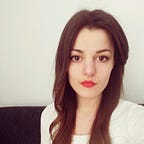Home office & mental health
It’s week 6 in Ironhack’s UX/UI design bootcamp, project 3 is about to begin and the situation is following;
The Daily Health Conference — a non-profit organization dedicated to promoting health and wellness through impactful public talks, participatory workshops, and professional training all over the world.
Technology is causing massive disruption in the health and wellness industry and the conference board is excited to offer more value to its members by exploring how technology can be used to help people live healthier lives in new ways. Therefore, they’ve organized a competition for the upcoming conference.
Participating designers will:
Conduct UXR to understand wellness habits & goals
Prototype an MVP of a disruptive & motivating tool
Pitch their ideas in front of a jury
The membership offering expansion of winning concepts will be revealed at this year’s conference!
Wellness is an aspect that can easily be overlooked in the bootcamp environment. Getting to know my teammate after the given brief, we automatically connected over some habits we had in common. Recognising how we could both benefit from a tool that would provide us with smart organisational system, which at the same time includes a safe space that supports mental health, we were inspired to dive into the research.
Quantitative research
For the first time in our bootcamp we were asked to attempt quantitative research, aiming to reach 100 responses, we created a google form and started sharing it left and right. Approximately 48 hours later, we managed to reach 60 responses and some of our key findings were summed up in the photo below.
Competitive analysis
Looking the market, we compared some of the most popular wellness apps that support mental health and well being. We analysed the features they offered and positioned them on market, considering our aspect of organization and disruptive feature of automation. Finding there was a gap in the market, clearly showing lack of organisational tools within wellness apps, our process continued in this direction.
Qualitative research
Led by what we’ve learned until this point, we prepared interview questions to further explore habits, conditions, preferences and opinions of our users. Altogether we conducted five interviews, gathering more necessary details on vital questions, while tapping into some experimental waters at the same time. In this data organization, we color-coded the answers and put them together under the same category/question.
“I love the reminders & calendars, ticking tasks gives me sense of accomplishment that I finished a task.”
Affinity diagram
Clustering the data from qualitative research resulted with categories, sub-categories and sub-sub? categories, jokes aside, no information was left uncategorised. Inspired by received feedback, we used dot-voting method to focus on the; breaks, co-working spaces and overall support.
Traveling Trevor
Forming our learnings into primary user persona, we introduced Trevor.
His journey map started with some exciting news which quickly led to the feeling of being overwhelmed and lost…
We asked ourselves, how might we help Trevor organize himself professionally as well as privately, while also offering an easy way to find new co-working spaces in new locations. This helped us define our problem statement:
Remote workers and students need to find a way to, have support for their mental health through better organization because it is effecting the quality of their life.
Ideation
MoSCoW
All ideas generated in the ideation activity known as Crazy 8’s were prioritized using MoSCoW. Must-haves are in yellow, with Should-haves right underneath. On the top right, there are our Could-haves, and lastly, Won’t-have features.
The MVP statement
Concept in Lo-Fi
We took to concept development individually as homework that evening, with a thought to do it while relaxing after full day of bootcamp activities and well deserved dinner. Both concepts included task page as a main priority, necessary navbar, earlier mentioned professional/private mode and other features supporting MVP statement.
User Flow
Main flow was focused on adding and editing a task, (dis)connecting it with automation feature. Additionally, Trevor marks the task done, to feel that sense of accomplishment, then using the toggle switches to private mode and adds a task. There is a privacy pop-up between the mode switch, where user must put in a PIN or scan their fingerprint for verification. In the end Trevor wants to take a look at the available co-working spaces where he can explore his options.
Mid-Fi
On the image below we see some mid-fi wireframes with comments and some iteration, for example ‘Journaling’ space was called ‘Check-in’ before, that term was used during concept stage but it ran into a feedback of lacking clarity.
Stop
Let’s play this game, take a few moments to look at our moodboard, then close your eyes and think, which few words are first to come to your mind?
Brand Attributes / Solution
- Balance
- Professional
- Supportive
- Organised
- Intentional
How close was it?
Feel free to leave a comment whit the attributes that came into your mind!
Design Critique
We checked our paddings and margins, we removed some inner shadows and removed most gradients. After some additional feedback we received in design critique and actioned afterwards, we were able to create a stile tile:
Hi-Fi prototype
This is it! The wait is over and we are presenting you with video of our hi-fi prototype a.k.a. final result.
Learnings
Let’s not forget there was a fraction of personal aspect in this project. Well, truth be told, while the project was ongoing there was some stormy waters and I can tell you for sure, not every collaboration is smooth sailing. However there were so many amazing learning opportunities, not necessarily involving designing skills, but yet, very valuable. In conclusion, we would totally benefit from using our own app, in proper time management for one… but that’s exactly the thing about these kind of apps, they only work if you do.
